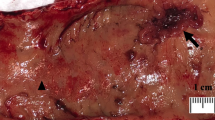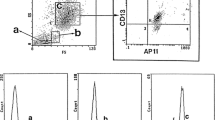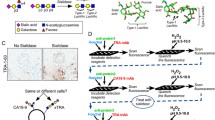Abstract
The immunohistochemical expression of sialylated and non-sialylated forms of both Lex and Lea were studied in 87 carcinomas and 42 normal mucosal specimens of colon and rectum, as well as in 32 metastatic lymph nodes and 9 hepatic lesions, using an indirect immunoperoxidase staining. Their antigens were expressed in normal mucosa with the following frequencies: Lea, 95.2% (40/42); sialyl Lea, 88.1% (37/42); Lex, 95.2% (40/42); and sialyl Lex, 17.0% (7/42), whereas in carcinomas, the respective rate of frequency were: 78.2% (68/87); 78.2% (68/87); 90.8% (79/87); and 93.1% (81/87). Sialyl Lex antigen showed the highest tumor specificity compared to other antigens. In three normal mucosal specimens and four carcinomas with Le(a−b−) phenotype, the expression of type 1 antigens (Lea and sialyl Lea) was not consistent, whereas type 2 antigens (Lex and sialyl Lex) were consistently observed in carcinomas. The staining of type 1 antigens and Lex was decreased in metastatic lesions compared with primary carcinomas, whereas sialyl Lex antigen had the same positive-staining rate in both. Metastatic carcinoma expressed the sialylated form more predominantly than the non-sialylated form in type 2 antigens whereas the opposite result was observed in type 1 antigens. These results suggested that: (a) sialyl Lex, defined by monoclonal antibody CSLEX1, may be useful as a tumor-associated antigen in colorectal carcinoma, and (b) the alteration of Lewis-related carbohydrate antigens in cancer cell membranes, including sialylation and/or aberrant glycosylation, may be related to metastatic behavior.
Similar content being viewed by others
References
Koprowski H, Steplewski Z, Mitchell K, et al. Colorectal carcinoma antigens detected by hybridoma antibodies. Soma Cell Genet 1979;5:957–972.
Magnani JL, Nilsson B, Brockhause M, et al. A monoclonal antibody-defined antigen associated with gastrointestinal cancer is a ganglioside containing sialylated lacto-N-fucopentaose II. J Biol Chem 1982;257:14365–14369.
Fukushima K, Hirota M, Terasaki PI, et al. Characterization of sialosylated Lewisx as a new tumor-associated antigen. Cancer Res 1984;44:5279–5285.
Hirota M, Fukushima K, Terasaki PI, et al. Sialosylated Lewisx in the sera of cancer patients detected by a cell-binding inhibition assay. Cancer Res 1985;45:1901–1905.
Iguro T. Application of monoclonal antibody to detect the red cell-associated antigen Lewisx and sialylated Lewisx in the serum of cancer patients. J Jpn Surg Soc 1987;88:1407–1414.
Hakomori S. Aberrant glycosylation in cancer cell membranes as focused on glycolipids: Overview and perspectives. Cancer Res 1985;45:2405–2414.
Galton J, Terasaki PI, Wakisaka, A, et al. A monoclonal antibody reactive with colonic, gastric, and pancreatic adenocarcinomas. In: Proc 9th int convoc immunol, Amherst 1984;117–125.
Magnani J, Steplewski Z, Koprowski H, et al.. Identification of the gastrointestinal and pancreatic cancer-associated antigen detected by monoclonal antibody 19-9 in the sera of patients as mucin. Cancer Res 1983;43:5489–5492.
Brockhaus M, Magnani JL, Blaszczyk M, et al. Monoclonal antibodies directed against the human Leb blood group antigen. J Biol Chem 1981;256:13223–13225.
Hakomori S, Nudelman E, Levery S, et al. The hapten structure of a developmentally regulated glycolipid antigen (SSEA-1) isolated from human erythrocytes and adenocarcinoma: A preliminary note. Biochem Biophys Res Commun 1981;100: 1578–1586.
Brockhaus M, Magnani JL, Herlyn M, et al. Monoclonal antibodies directed against the sugar sequence of lacto-N-fucopentaose III are obtained from mice immunized with human tumors. Arch Biochem Biophys 1982;217:647–651.
Huang LC, Brockhaus M, Magnani JL, et al. Many monoclonal antibodies with an apparent specificity for certain lung cancers are directed against a sugar sequence found in lacto-N-fucopentaose III. Arch Biochem Biophys 1983;220:318–320.
Hakomori S, Nudelman E, Levery SB, et al. Novel fucolipids accumulating in human adenocarcinoma. I. Glycolipids with di-or tri-fucosylated type 2 chain. J Biol Chem 1984;259: 4672–4680.
Yang H-J, Hakomori S. A sphingolipid having a novel type of ceramide and “lacto-N-fucopentaose III”. J Biol Chem 1971; 246:1192–1200.
Watkins WM. Genetic regulation of the structure of blood group-specific glycoproteins. Biochem Soc Symp 1974;40: 125–146.
Schwartz SI. Colon, rectum, and anus. Principles of surgery. 3rd ed. New York: McGraw-Hill 1979;1214–1215.
Arends JW, Verstynen C, Bosman FT, et al. Distribution of monoclonal antibody-defined monosialoganglioside in normal and cancerous human tissues: An immunoperoxidase study. Hybridoma 1983;2:219–229.
Koprowski H, Blaszcyk M, Steplewski Z, et al. Lewis blood type may affect the incidence of gastrointestinal cancer. Lancet 1982;1:1332–1333.
Hakomori S. Glycosphingolipids in cellular interaction, differentiation, and oncogenesis. Ann Rev Biochem 1981;50:733–764.
Arends JW, Wiggers T, Verstijnen C, et al. Gastrointestinal cancer-associated antigen (GICA) immunoreactivity in colorectal carcinoma in relation to patient survival. Int J Cancer 1984;34:193–196.
Walker RA, Day SJ. Expression of the antigen detected by the monoclonal antibody Ca 19.9 in human breast tissues. Virchows Arch 1986;409:375–383.
Cordon-Card C, Reuter VE, Finstad CL, et al. Blood group-related antigens in human kidney: Modulation of Lewis determinants in renal cell carcinoma. Cancer Res 1989;49:212–218.
Irimura T, Ota DM, Cleary KR.Ulex europeus agglutinin I-reactive high molecular weight glycoproteins of adenocarcinoma of distal colon and rectum and their possible relationship with metastatic potential. Cancer Res 1987;47:881–889.
Hoff SD, Matsushita Y, Ota DM, et al. Increased expression of sialyl-dimeric Lex antigen in liver metastases of human colorectal carcinoma. Cancer Res 1989;49:6883–6888.
Inufusa H, Kojima N, Yasutomi M, et al. Human lung adenocarcinoma cell lines with different lung colonization potential (CLP), and a correlation between expression of sialosyl dimeric Lex (defined by mAb FH6) and LCP. Clin Exp Metastasis 1991;9:245–257.
Phillips ML, Nudelman E, Gaeta FC, et al. ELAM-1 mediates cell adhesion by recognition of a carbohydrate ligand, sialyl-Lex. Science 1990;250:1130–1132.
Walz G, Aruffo A, Kolanus W, et al. Recognition by ELAM-1 of the sialyl-Lex determinant on myeloid and tumor cells. Science 1990;250:1132–1134.
Hession C, Osborn L, Goff D, et al. Endothelial leukocyte adhesion molecule 1: Direct expression cloning and functional interactions. Proc Natl Acad Sci USA 1990;87:1673–1677.
Author information
Authors and Affiliations
Rights and permissions
About this article
Cite this article
Nakagoe, T., Fukushima, K., Hirota, M. et al. An immunohistochemical employer monoclonal antibodies against Lea, sialyl Lea, Lex, and sialyl Lex antigens in primary colorectal, carcinomas and lymph node and hepatic lesions. J Gastroenterol 29, 129–138 (1994). https://doi.org/10.1007/BF02358673
Received:
Accepted:
Issue Date:
DOI: https://doi.org/10.1007/BF02358673




